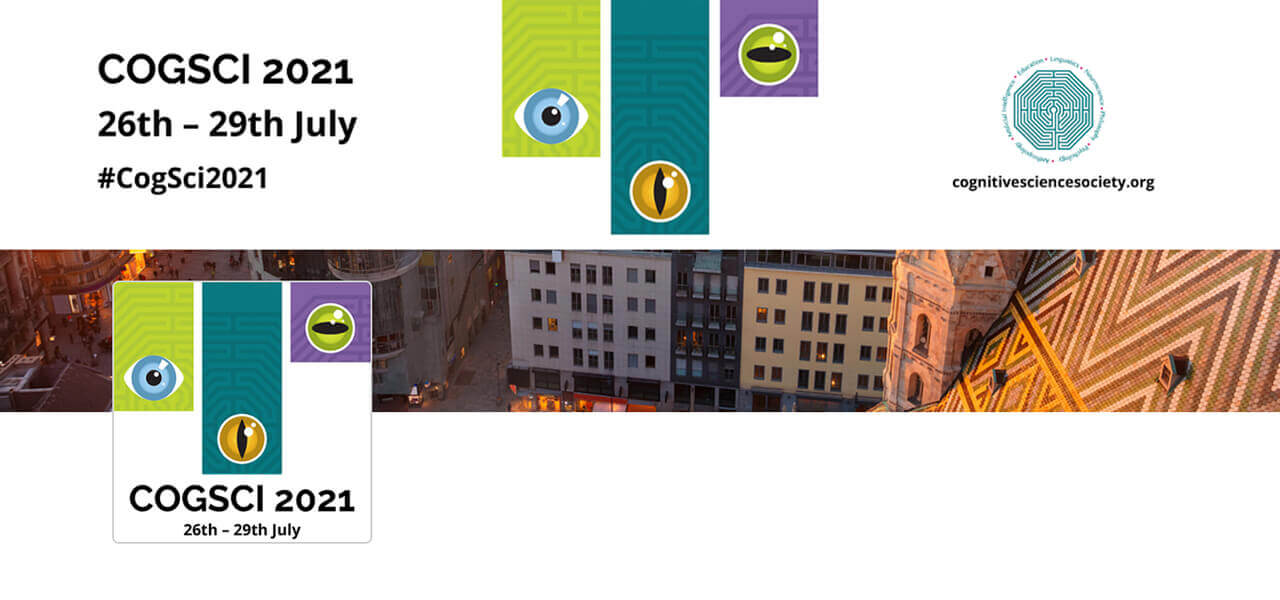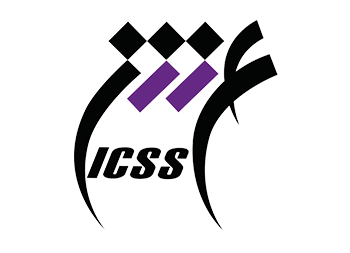کنفرانس مجازی انجمن بین المللی علوم شناختی

امسال چهل و سومین نشست انجمن بین المللی علوم شناختی بصورت مجازی در تاریخ ۴ تا ۸ مرداد برگزار شد. در این همایش چندین سخنرانی کلیدی، ۱۵۲ ارائه شفاهی، ۳۳۲ پوستر، ۱۲ سمپوزیوم و ۹ کارگاه وجود داشت. بررسی مطالب ارائه شده در این همایش سطح مطالعات علوم شناختی در کشورهای دیگر را نشان میدهد و برای اطلاع اساتید و دانشجویان از روند توسعه علوم شناختی به عنوان یک حوزه بینارشتهای بسیار مفید است.
در اینجا فهرست سخنرانیهای ارائه شده در کنفرانس را که براساس گروههای آموزشی موسسه دستهبندی شده است، مشاهده می کنید. پی دی اف مقالات و ویدئوی سخنرانیهای ارائه شده در کنفرانس نیز در کتابخانه موجود است و علاقمندان میتوانند نسخه آنها را از کتابخانه دریافت دارند.
Key Note Speakers
Berg work with Weiji
Brain pathways for vocal learning and spoken language
Explaining as dialogic process
Neural Basis of Planning- by Lee
The Mind Hidden in Our Hands-Susan Goldin-Meadow (Language and Thought)
Uncertainty in the Cortex by Jehee
Why are the Birds So Smart
Why do we love music? A view from cognitive neuroscience
Presentations
AI and Cognitive Modeling
A common framework for quantifying the learnability of nouns and verbs
Are people still smarter than machines? If so, why?
Compression-A Lossless Mechanism for Learning Complex Structured Relational Representations
Different kinds of cognitive plausibility- why are transformers better than RNNs at predicting N400 amplitude?
Do language models learn typicality judgments from text?
Explaining as dialogic process
Feature encoding modulates cue-based retrieval-Modeling interference effects in both grammatical and ungrammatical sentences
How to Revise Beliefs from Conditionals-A New Proposal
Infants’ Social Communication from a Predictive Processing Perspective
Interaction Flexibility in Artificial Agents Teaming with Humans
Learning Approximate and Exact Numeral Systems via Reinforcement Learning
Memory Constraints on Cross Situational Word Learning
Modeling Object Recognition in Newborn Chicks using Deep Neural Networks
On Factors Influencing Typing Time- Analyzing TypeRacer’s Massive Open Access Datasetmp4
Planning to plan-a Bayesian model for optimizing the depth of decision tree search
Reason-Based Constraint in Theory of Mind
Testing a theory of similarity in preferential choice
The Structure of Team Search Behaviors with Varying Access to Information
When Does an Individual Accept Misinformation?
Why is scaling up models of language evolution hard?
Word Probability Re-Estimation Using Topic Modeling and Lexical Decision Data
Cognitive Development
Development -Social
Children Use Artifacts to Infer Others’ Shared Interests
Do You Know What I Know? Children Use Informants’ Beliefs About Their Abilities to Calibrate Choices During Pedagogy
Language- and spatially-mediated attention in toddlers
Multimodal Behaviors from Children Elicit Parent Responses in Real-Time Social Interaction
Open-Minded, Not Naïve- Three-Month-Old Infants Encode Objects as the Goals of Other People’s Reaches
Social factors modulate children’s (Homo sapiens) resource control abilities in natural peer groups
Development and Learning
Children’s Novelty Preferences Depend on Information-Seeking Goals
Developmental changes in perceived moral standing of robots
Incidental discrete emotions influence processes of evidence accumulation in reinforcement-learning
Infants’ interpretation of information-seeking actions
Modeling the Mistakes of Boundedly Rational Agents Within a Bayesian Theory of Mind
Nature and origins of intuitive psychology in human infants
Development Models
Characterizing the object categories two children see and interact with in a dense dataset of naturalistic visual experience
Combining rules and simulation to explain infant physical learning
Examining Infant Relation Categorization Through Deep Neural Networks
In-the-Moment Visual Information from the Infant’s Egocentric View Determines the Success of Infant Word Learning-A Computational Study
Predicting children’s and adults’ preferences in physical interactions via physics simulation
Gesture and Development
Comparative perspectives on gesture and the evolution of language
Early identification of developmental delay and disorder- What we can learn from gesture, speech, and the dynamics of the communicative process
How, when and why early gesture use predicts language development
In search of a mechanism- Unpacking the effects of hand gesture on math learning
Language Development
A crosslinguistic study of the acquisition of time words in English- and German-speaking children
Chaining and the formation of spatial semantic categories in childhood
Child-directed Listening- How Caregiver Inference Enables Children’s Early Verbal Communication
Children know what words other children know
Expectation Violation Leads to Generalization- The Effect of Prediction Error on the Acquisition of New Syntactic Structures
Frequency vs. Salience in First Language Acquisition-The Acquisition of Aspect Marking in Chintang
Large-scale study of speech acts’ development using automatic labelling
Learning communicative acts in children’s conversations- a Hidden Topic Markov Model analysis of the CHILDES corpus
Modelling the development of counting with memory-augmented neural networks
Quantifying Lexical Ambiguity in Speech To and From English-Learning Children
Spatial Language Use Predicts Spatial Memory of Children-Evidence from Sign, Speech, and Speech-plus-gesture
Learning
A formal comparison/contrast of associative and relational learning-a case study of relational schema induction
A Mixture of Experts in Associative Generalization
A novel non-linguistic audio-visual learning paradigm to test the cognitive correlates of learning rate
Can Closed-ended Practice Tests Promote Understanding from Text?
Superordinate Word Knowledge Predicts Longitudinal Vocabulary Growth
The Value of Learning and Cognitive Control Allocation
Reading
Eye Movement Traces of Linguistic Knowledge
Eye movements when reading spaced and unspaced texts in Arabic
On the Role of Low-level Linguistic Levels for Reading Time Prediction
The Optimal Amount of Visuals Promotes Children’s Comprehension and Attention-An Eye Tracking Study
Using Simulations to Understand the Reading of Rapidly Displayed Subtitles
Cognitive Neuroscience
A comparative perspective with a New Framework-the ALARM theory of consciousness
Berg work with Weiji
Brain pathways for vocal learning and spoken language
Challenges for using Representational Similarity Analysis to Infer Cognitive Processes-A Demonstration from Interactive Activation Models of Word Reading
Generalisation in the hippocampal formation
Infants’ Social Communication from a Predictive Processing Perspective
Improving Medical Image Decision Making by Leveraging Metacognitive Processes and Representational Similarity
Investigating the neurocognitive development of human memory using high-resolution magnetic resonance imaging
Lab-based comparative investigations of multimodal sexual signalling
Learning exceptions to the rule in human and model via hippocampal encoding
Memory engrams across development
Neural Basis of Planning- by Lee
The development of circuits supporting the brain’s representation of space
The Role of The Basal Ganglia in the Human Cognitive Architecture-A Dynamic Causal Modeling Comparison Across Tasks and Individuals
Uncertainty in the Cortex by Jehee
Why are the Birds So Smart
Why do we love music? A view from cognitive neuroscience
Why We Should Report Colorimetric Data In Every Paper
Cognitive Psychology
Animal consciousness in comparison to human consciousness
A comparative perspective with a New Framework-the ALARM theory of consciousness
Evolutionary markers and the emergence of consciousness
The dynamics of consciousness, without words
The evolution of consciousness-Origins and effects
Categorization
Categorical perception of p-values
Comparison Promotes the Spontaneous Transfer of Relational Categories
Designing probabilistic category learning experiments-The probabilistic prototype distortion task
Individual Variability in Strategies and Learning Outcomes in Auditory Category Learning
The Dynamics of Exemplar and Prototype Representations Depend on Environmental Statistics
Cognition of Time
Context-dependent need for sleep in the consolidation of memory
From hibernation to depression- brown fat as the missing link between seasonality and affective behavior
Time for Music
Timely Decisions
Cognitive perspective
Are people still smarter than machines? If so, why?
Cross-language structural priming in recurrent neural network language models
How does the Chimpanzee Mind Represent its Cultures?
Optimal denomination signalling in currencies
Size ordering as a cognitive principle for numerical systems
Wayfinding, directional indicators and land-surveying in Ancient Rome
Writing systems and graphic complexity
Comparative approaches to memory development
Investigating the neurocognitive development of human memory using high-resolution magnetic resonance imaging
Memory development in early childhood
Memory engrams across development
Resource depletion and recovery in human memory
The development of circuits supporting the brain’s representation of space
Comprehension
Can Closed-ended Practice Tests Promote Understanding from Text?
Coherence-Building in Multiple Document Comprehension
Just Following Directions! The Effects of Gender on Direction Giving
Loopholes, a Window into Value Alignment and the Learning of Meaning
Multi-Level Linguistic Alignment in a Virtual Collaborative Problem-Solving Task
The Effects of Onset and Offset Masking on the Time Course of Non-Native Spoken-Word Recognition in
What did I sign? A study of the impenetrability of legalese in contracts
Conceptual foundations of sustainability
Conceptualisations of landscapes across cultures
Science doubt, resistance, and denial-Implications for sustainability education and communication
Sustainability and folk theories of artefact creation
What does it take to love a bug?
Explanation in human thinking
Counterfactual explanations in explainable AI
Explaining as dialogic process
How people judge the completeness of an explanation
The potential of illusionism for investigating explanation in human thinking
Humans and Cognition
A conceptual framework for empathy and its application to investigate nonhuman animals
Cognitive and Cultural Diversity in Human Evolution
The Emergence of Cultural Attractors-An Agent-Based Model of Collective Perceptual Alignment
Memory
Cognitive and Cultural Diversity in Human Evolution
Context-dependent need for sleep in the consolidation of memory
Infants’ Social Communication from a Predictive Processing Perspective
Investigating the neurocognitive development of human memory using high-resolution magnetic resonance imaging
Language- and spatially-mediated attention in toddlers
Memory development in early childhood
Memory engrams across development
Modeling Object Recognition in Newborn Chicks using Deep Neural Networks
Parent-Child Conversation About Negative Aspects of the Biological World
People Adjust Recency Adaptively to Environment Structure
Resource depletion and recovery in human memory
The development of circuits supporting the brain’s representation of space
Towards a Cognitive Model of Collaborative Memory
Uncertainty in the Cortex by Jehee
Multimodal signalling of attractiveness
Development and learning of multimodal mating signals
Lab-based comparative investigations of multimodal sexual signalling
Spontaneous integration of facial and vocal information during judgements of attractiveness
Stable first impressions from the voice and face
Perception
Automatic computation of navigational affordances explains selective processing of geometry in scene perception-behavioral and computational evidence
Chunks are not “Content-Free”- Hierarchical Representations Preserve Perceptual Detail within Chunks
Hierarchical syntactic structure predicts listeners’ sequence completion in music
Jointly Perceiving Physics and Mind-Motion, force and intention
Perception of soft materials relies on physics-based object representations-Behavioral and computational evidence
Perceptual Processes of Face Recognition- Single feature orientation and holistic information contribute to the face inversion effect
The psychophysics of number arise from resource-limited spatial memory
Visual scoping operations for physical assembly
Where Word and World Meet- Intuitive Correspondence Between Visual and Linguistic Symmetry
Vision
A confirmation bias due to approximate active inference
Identifiability and Specificity of the Two-Point Visual Control Model of Steering
Improving Medical Image Decision Making by Leveraging Metacognitive Processes and Representational Similarity
Relating confidence judgements to temporal biases in perceptual decision-making
Three-dimensional pose discrimination in natural images of humans
Cognitive Science and Decision Making
Judgement and Decision
Deciding to be Authentic- Intuition is Favored Over Deliberation for Self-Reflective Decisions
People Adjust Recency Adaptively to Environment Structure
Possibility judgments may depend on assessments of similarity to known events
Preference reversals between intertemporal choice and pricing
Moral & choices
A model of selection history in visual attention
Dimensions of Moral Status
Embodied morality-Repetitive motor actions change moral decision-making
Parent-Child Conversation About Negative Aspects of the Biological World
Risks and Decision Making
Evaluating Transformative Decisions
How Goals Erase Framing Effects in Risky Decision Making
Information sampling for contingency planning
Measuring and predicting variation in the interestingness of physical structures
Risk-taking in adversarial games-What can 1 billion online chess games tell us?
Similarity-based influences in judgment and decision making
Do people shift among or blend rule- and memory-based judgments?
Similarity-based Influences in Judgment and Decision Making 2
Socializing social sampling models
Testing a theory of similarity in preferential choice
Planning and decision making
Deciding to be Authentic- Intuition is Favored Over Deliberation for Self-Reflective Decisions
Do people shift among or blend rule- and memory-based judgments?
Evaluating Transformative Decisions
How Goals Erase Framing Effects in Risky Decision Making
Incidental discrete emotions influence processes of evidence accumulation in reinforcement-learning
Information sampling for contingency planning
Measuring and predicting variation in the interestingness of physical structures
Modeling the Mistakes of Boundedly Rational Agents Within a Bayesian Theory of Mind
Neural Basis of Planning- by Lee
People Adjust Recency Adaptively to Environment Structure
Possibility judgments may depend on assessments of similarity to known events
Preference reversals between intertemporal choice and pricing
Relating confidence judgements to temporal biases in perceptual decision-makin
Risk-taking in adversarial games-What can 1 billion online chess games tell us?
Similarity-based Influences in Judgment and Decision Making
Socializing social sampling models
Testing a theory of similarity in preferential choice
Uncertainty in the Cortex by Jehee
Cognitive Science-Design and Creativity
Conceptualisations of landscapes across cultures
Science doubt, resistance, and denial-Implications for sustainability education and communication
Similarity-based Influences in Judgment and Decision Making 2
Sustainability and folk theories of artefact creationimilarity-based Influences in Judgment and Decision Making 2
Writing systems and graphic complexity
Cognitive Education
A computational framework for learning and transforming task representations
Children Use Artifacts to Infer Others’ Shared Interests
Do You Know What I Know? Children Use Informants’ Beliefs About Their Abilities to Calibrate Choices During Pedagogy
Eye movements when reading spaced and unspaced texts in Arabic
Social factors modulate children’s (Homo sapiens) resource control abilities in natural peer groups
The Optimal Amount of Visuals Promotes Children’s Comprehension and Attention-An Eye Tracking Study
Cognitive Linguistics: Language development
A crosslinguistic study of the acquisition of time words in English- and German-speaking children
Chaining and the formation of spatial semantic categories in childhood
Child-directed Listening- How Caregiver Inference Enables Children’s Early Verbal Communication
Children know what words other children know
Expectation Violation Leads to Generalization- The Effect of Prediction Error on the Acquisition of New Syntactic Structures
Frequency vs. Salience in First Language Acquisition-The Acquisition of Aspect Marking in Chintang
Large-scale study of speech acts’ development using automatic labelling
Learning communicative acts in children’s conversations- a Hidden Topic Markov Model analysis of the CHILDES corpus
Modelling the development of counting with memory-augmented neural networks
Quantifying Lexical Ambiguity in Speech To and From English-Learning Children
Spatial Language Use Predicts Spatial Memory of Children-Evidence from Sign, Speech, and Speech-plus-gesture
Linguistics
A bathtub by any other name- the reduction of German compounds in predictive contex
A computational framework for learning and transforming task representations
A crosslinguistic study of the acquisition of time words in English- and German-speaking children
Arguing with experts-Subjective disagreements on matters of taste
Brain pathways for vocal learning and spoken language
Coin it up-Generalization of creative constructions in the wild
Come Together-Integrating Perspective Taking and Perspectival Expressions
Cross-language structural priming in recurrent neural network language models
Disentangling factors in the placement of manner adverbials in German-the effect of distributional similarity
Do gestures really facilitate speech production?
Event visibility in sign language motion-Evidence from Austrian Sign Language (ÖGS)
Explaining as dialogic process
Large-scale study of speech acts’ development using automatic labelling
Let’s talk (efficiently) about us-Person systems achieve near-optimal compression
Lexically-Mediated Compensation for Coarticulation in Older Adults
Listeners evaluate native and non-native speakers differently (but not in the way you think)
Pragmatic factors can explain variation in interpretation preferences for quantifier-negation utterances-A computational approach
Quantifiers satisfying semantic universals are simpler
Sensory Modality of Input Influences the Encoding of Motion Events in Speech But Not Co-Speech Gestures
Spatial Language Use Predicts Spatial Memory of Children-Evidence from Sign, Speech, and Speech-plus-gesture
The Mind Hidden in Our Hands-Susan Goldin-Meadow (Language and Thought)
The Shape of Modified Numerals
Towards a mechanistic account of speech comprehension
Towards an ecologically valid neurobiology of multilingualism
Sequential meaning-making in language and visual narratives
An oscillatory perspective on visual narrative comprehension
Inferential techniques in visual narrative storytelling
Information density in visual narrative units and sequences
Linguistic Typology of Motion Events in Visual Narratives
Cognitive Science-Media
Computational challenges in explaining communication-How deep the rabbit hole goes
Extending rational models of communication from beliefs to actions
I Know You Know I’m Signaling- Novel gestures are designed to guide observers’ inferences about communicative goals
Learning to communicate about shared procedural abstractions
The Emergence of Cultural Attractors-An Agent-Based Model of Collective Perceptual Alignment
Understanding distal goals from proximal communicative actions
Visual communication of object concepts at different levels of abstraction
Philosophy and Cognitive Science
A comparative perspective with a New Framework-the ALARM theory of consciousness
Cognitive and Cultural Diversity in Human Evolution
Counterfactual explanations in explainable AI
Evolutionary markers and the emergence of consciousness
Explaining as dialogic process
How people judge the completeness of an explanation
Jointly Perceiving Physics and Mind-Motion, force and intention
The evolution of consciousness-Origins and effects
Social Cognition
Moral & Choices
A model of selection history in visual attention
Dimensions of Moral Status
Embodied morality-Repetitive motor actions change moral decision-making
Parent-Child Conversation About Negative Aspects of the Biological World
Social – Groups, norms, culture
Cognitive Properties of Norm Representations
Investigating cross-cultural differences in reasoning, vision, and social cognition through replication
Social meta-inference and the evidentiary value of consensus
The Structure of Team Search Behaviors with Varying Access to Information
Tolerance to failure unleashes the benefits of cognitive diversity in collective problem solving
Social and Judgement
Categorical Belief Updating Under Uncertainty
How People Make Causal Judgments about Unprecedented Societal Events
I can tell you know a lot, although I’m not sure what- Modeling broad epistemic inference from minimal action
Lies are crafted to the audience
What we ought to do is…’- Are we More Willing to Defer to Experts who Provide Descriptive Facts Than Those who Offer Prescriptive Advice?
Other Materials
Causation by Ignorance
How does the Chimpanzee Mind Represent its Cultures?
Modeling joint attention from egocentric vision
Reasoning about social attitudes with uncertain beliefs
Towards a Cognitive Model of Collaborative Memory
Who went fishing? Inferences from social evaluations
مطالب مرتبط

نشانی جدید کانال اطلاع رسانی موسسه آموزش عالی علوم شناختی در تلگرام
۲۸ / فروردین / ۱۴۰۳
ثبت نام برای شرکت در دهمین همایش بین المللی علوم شناختی شروع شد
۲۴ / فروردین / ۱۴۰۳

پیام تبریک رییس موسسه به مناسبت فرارسیدن عید فطر
۲۱ / فروردین / ۱۴۰۳


